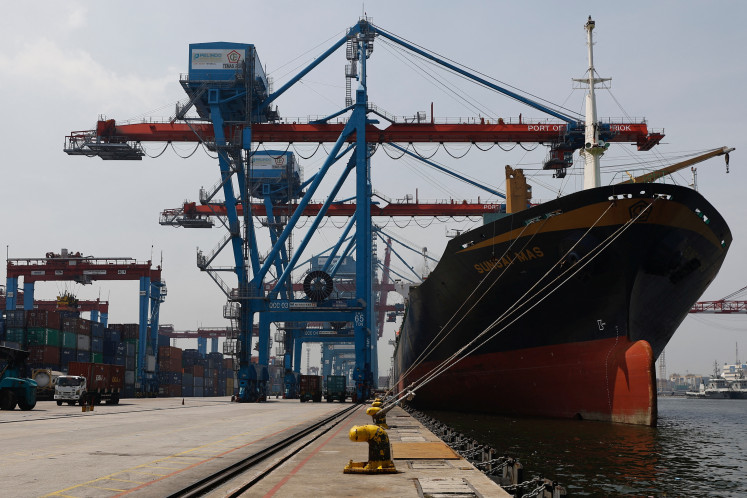A herculean task to recover peatlands
Nazir Foead - JP/Wendra AjistyatamaAs the leader of the newly-established Peatland Restoration Agency (BRG), conservation veteran Nazir Foead is President Joko “Jokowi” Widodo’s front man in the fight against the annual haze
Change text size
Gift Premium Articles
to Anyone

Nazir Foead - JP/Wendra Ajistyatama
As the leader of the newly-established Peatland Restoration Agency (BRG), conservation veteran Nazir Foead is President Joko “Jokowi” Widodo’s front man in the fight against the annual haze. The 49-year-old is tasked with leading a national effort to restore fire-prone peatland and curb the recurring fire risk, which last year shortchanged Indonesia’s economy of US$16 billion and catapulted the country passed Japan as the world’s fifth biggest polluter. He recently talked to The Jakarta Post’s Hans Nicholas Jong about his priorities as the head of the BRG as well as the challenges of restoring more than 2 million hectares of damaged peatland in the next five years.
Question: What is your main priority as the head of the BRG now that the agency has mapped 2.26 million hectares of priority areas to be restored?
Answer: BRG will produce a 1:50,000 scale map to identify priority restoration areas, and set zonation of peat conservation and cultivation areas. This will certainly help all stakeholders to start working together in restoring land under their control.
At the same time, we are completing the BRG’s action plan, a technical guidance for rewetting and revegetation, as well as creating social safeguards and community empowerment. The technical guidance and the map are a reference for land managers and land owners to embark on restoration activities.
The BRG will also have to build a monitoring scheme before the end of the year. This scheme will spot unfitting practices, therefore, corrective measures can be immediately applied. We should not allow mistakes to go on without check.
You are a conservation veteran, but you had never worked in the bureaucracy or the corporate world before. How did you manage the transition from a conservationist to a leader of a government agency?
In my previous career, I had shared knowledge with government agencies at national and sub-national levels, as well as with corporations, from the level of executives to field workers. I often joined government meetings, in identifying issues and deciding on actions needed to tackle conservation issues.
I learned much from our communication, realizing the gaps of knowledge and interests between different parties. These experiences taught me a lot. Now in my capacity at the BRG, I also work closely with the Environment and Forestry Minister and the Presidential Office head to set policy directions for peatland restoration. I understand that a common platform of peatland restoration requires intensive and effective communication among government agencies at different levels.
How does your previous background as the conservation director at WWF Indonesia and the leader of the Indonesia conservation initiative for the Climate and Land Use Alliance (CLUA) help your current task?
They both provided me a strong network of NGOs and donors. We fully realize that our work in the BRG needs strong support from community groups and NGOs or CSOs. Indonesia has set a very clear target to no longer experience haze problems, which was decided last year both in Indonesia and at the international Paris COP forum.
We see the role international partners and donors can play to support us, and we want Indonesia to be successful in this extraordinary task of restoring 2 million hectares of peatland. We so far have gained the trust of international partners and this is our modality for success.
What would you say your challenges as head of the BRG are?
My recent trip to Japan showed me that it took 10 years for the Japanese government to restore a canal of 1.6 kilometer in a peatland area of Hokkaido.
It took them five years to settle the agreement with farmers and prepare a comprehensive work plan. We ought to restore thousands of kilometers in five years over 2 million hectares. We are racing against time.
Out of 2.26 million hectares of peatland to be restored in the next five years, about 1.9 million hectares are in cultivation areas. How will you restore the peatland in cultivation areas owned by companies? What if they are unwilling to restore their concessions?
We believe companies don’t want to see their land burnt again, which will bring them bigger problems in the future, including prosecution from law enforcement officials. It is our shared goal to restore the degraded peatland, to rewet them so it won’t catch fire.
And some companies have done quite a lot to this end. We now want more companies, who hold concessions in degraded peatland, to exercise restoration actions properly. We will also assist them in resolving conflicts with communities, which have been quite an issue for them. It is a give and take initiative.
What about those in community lands? Will there be different approaches?
For communities, we have to come up with a series of support for indigenous peoples and local communities in initiating peatland-friendly agriculture, and at the same time help them to get legal recognition of their land claims or access if they haven’t got it. We certainly will listen to what they need as well as to support them to revitalize their local wisdom of peatland management.
What is the BRG’s approach on disputed lands that fall in the agency’s restoration area?
We will apply different approaches depending on the causes of the conflicts. There will be several cases where companies and communities will have to share control of the conflicting land in the form of comanagement; other cases will see companies having to return land to communities. These all have to be arranged under sustainable principles, which provide benefits for both the community and companies.









